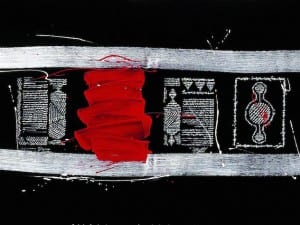Italian self-taught painter Beddru embraces experimentation with non-traditional materials, such as thick, superposed Plexiglas panels. He describes his figurative subjects as “unconformably” represented through ink-based mixed media, which are applied via reverse painting technique.
A: Your primary medium for working in is paint. Why do you think that painting still resonates within today’s contemporary society and what does it offer to you as an artist?
B: Painting, especially in its figurative form, represents our “historical memory” related to specific stages our society has gone through over the years — from the hieroglyphs on the walls of caves — to today’s computerised image-manipulation era. Enter David Hockney’s exhibition at Tate Britain and you’ll have a sense of the evolution of painting. It’s not the case that only in the last rooms do visitors enjoy his virtual paintings, on an iPad! The way we paint has visibly changed but what counts is that we still do it. It resonates in our minds because as human beings we function through emotions, and the medium represents a universal language that speaks simultaneously to our brain and to our heart. When we look at an artwork either we feel something, a connection, or we don’t. We all look for strong emotions, because this makes us feel alive.
A:Is there a message that you’re trying to convey within the works?
B: Well, sometimes after sketching the preparatory work for a painting I ask myself: “Why did you do it this way?” Anything we do has a reason. Sometimes we only understand it some time later. It is an interesting exercise as we connect dots backwards till we reach the source generating our inspiration. Painting helps me understand better who I am as a human being and how I function. All works have a message. It’s like I need to get it out of myself because the paintings want to tell me something. Collectors don’t need necessarily to know the reason why I painted a piece. They can see in the piece their own message. More than once people have seen in some of my paintings things I never meant to express and that’s fine with me. It’s even pretty amusing sometimes. Through my work I support value change and tolerance, so I am tolerant if the observer sees his/her own message in the piece!
A: The paintings are often colourful, filled with patterns and conveying one or two abstracted portraits. Is there a conceptual narrative that links all of them together?
B: Colour is a dimension that since the beginning has defined my style as an artist. I definitely see life in colour, and I believe in their energetic benefits. Therefore, I carefully choose my palette to create what I call a sense of chromatic pleasure. The artworks I paint have the primary mission of making their collectors feel good. Hanging a piece on your wall is a big responsibility. You will see it every day. So you should want to ensure you feel good with it. It’s very important for me that the collector is trapped in the magic of my colours; how they merge together and create marvelous effects on my Plexiglas sheets. By now people recognise straight away if a painting belongs to me.
This translates into the fact they recognise my own style, which is incredibly flattering! There are several themes I express through my works, but the common narrative starts and ends with me. It’s like a circle where the start and the end touch each other. I am part of each painting not just because I am the painter but also, mainly, because each artwork has a link with my past, present or expected future. The common narrative may have a title such as SAVE THE PAINTER FROM HIMSELF. The medium has saved me from the professional life that I carried out for a long time, whilst doing things that gave me little pleasure. The braveness of starting a new life, where art is at the centre, has reflected a strong mind-set. I was so ready to embrace change, as I see it as an opportunity for self-improvement.
A: How do you begin to plan a composition?
B: It’s mainly a brain exercise rather than a technical trial process. The Old Masters are known for researching the best composition in their paintings and this is something a painter may want to take into consideration but overthinking is never good. The risk is to kill the beauty of the “intuitive lines and brushes” making them look too rational in the end. When I observe drawings executed by children I am always amused because painting rules are not respected but the composition is there. They don’t think in composition terms but eventually they deliver it naturally. In my case I try to project mentally what I want to represent, the size of it, the colours, the space. It is usually a fast process, as I want the outcome to be genuine. I want the child that is in me to be the co-painter. The fact of being self-taught has turned into a strength rather than a weakness, as I do things differently.
A: Where do you get your inspiration from?
B: The tough job for an artist is to get new ideas and turn them into success. I paint in series but I know that when a block of works is completed I need to change and create a brand new one that has still to reflect who I am and be recognisable as mine. Inspiration is fortunately generated by many sources around me, people I am connected to, stories I am told, news I read, but the best place to catch inspiration is surely museums. I am just back from such an inspiring trip in Portugal where I got completely charmed by the Museum of Tiles in Lisbon (National Azulejo Museum). The patterns and the colours of the tiles are just mesmerizing. They gave me such good vibes that I want now to convey in my next paintings.
I have in mind the idea of developing a new series of portraits using a variation of the reverse-painting technique I am so much in love with. Last night I could not even sleep thinking of the first piece. I want all my artworks to look contemporary because I am a contemporary artist but inspiration comes usually from the past centuries. Renaissance is one of my favourite periods in art. It’s not the case that all the female characters in the ENIGMA series have Raphaellian traits. Also, the rich cross-cultural background of the island where I grew up, Sicily, continues to be a very solid platform for my inspiration.
A: You recently exhibited at the London Art Biennale – could you talk about the work you displayed, audience responses and what these types of events offer to artists like yourself?
B: The London Art Biennale was the perfect excuse to bring some of my works back to the beautiful Old Town Hall in Chelsea. I presented two artworks belonging to the ENIGMA and NATURART series. The title of the first artwork is SWAN NECK. It is part of the ENIGMA series that investigates enigmatic female characters mainly linked to some important aspects of my past. It pictures the idea of “hard work for survival” and after painting it I understood that I had somehow painted my mother, who did such a great job to support our family. Having an award assigned by the Jury for Excellence in Art, whilst my mother was present at the closing ceremony, was a pretty emotional moment for her but also a nice recognition for me as an emerging artist.
The second artwork is called COUPLE OF DIVERS and represents a summer scene with two male bodies diving into a Sicilian turquoise sea. The sea is a metaphor for pleasure. The entire series represents bodies jumping into the sea. They are all looking for a form of pleasure. The Gagliardi Gallery, on King’s Road, impeccably curated the organization of the Biennale, which represents a premium window for all selected artists. In fact, Elizabeth Mitchell D’Anna, director and owner of La Galleria Pall Mall in London, noticed my work and offered me the opportunity of a solo-exhibition this upcoming summer.
A: What do you have planned for this year?
B: The year looks pretty busy. A lot has happened already in the past months and I am now preparing for the next events. London, for my solo-exhibition in June, Brussels with Beddru curated by Stephanie Manasseh (Director of the Accessible Art Fair Brussels), and participation in Art Marbella in July, AAF New York in September displayed by my Los Angeles based gallery (Artspace Warehouse).
Things will get even more hectic in October where my time is going to be squeezed between The Accessible Art Fair Brussels in Bozar Museum and The Florence Biennale, one of the major contemporary art events in Italy. I will then exhibit at AAF Amsterdam in November. Miami will conclude the events in 2017. Meanwhile, I will also continue to support my gallery in Zürich (Kunstwarehaus) with new works, making my art more known amongst refined Swiss collectors. The participation in art shows usually depends on strategic planning done by the galleries that stand behind my work but there are events I would never miss in the year. One of them is the Accessible Art Fair in Brussels that marked my beginning as an artist several years ago. Stephanie Manasseh, the director, has been doing a terrific job showing strategic vision to gain International awareness and support the careers of selected artists she curates.
The other event I truly enjoy is the Affordable Art Fair Amsterdam. On one hand, I do support the concept of making Art affordable to anyone and, on the other, I really love working with Kris Clark, director of the fair. It’s a pleasure to support this event and show my artwork to the International audience the fair attracts every year.
www.beddru.com
www.facebook.com/Beddr
www.twitter.com/BeddruArt
Credits:
1. SYMBIOTHICA, Courtesy of Beddru.





